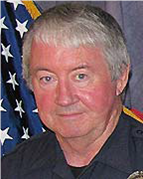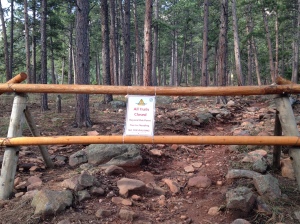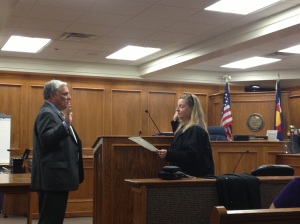By Lars Gesing
Lorenzo Gibson was on a mission to help when he went to Los Angeles in 1972. Two years down the road, he knew that help wasn’t just a passion out of necessity, but a profession. His profession.
Back in 1972, the 23-year-old Canada-born Gibson hadn’t even made plans yet to become a police officer when he arrived in California. A prior two-month Spanish language course in Utah had provided him with the requisite know-how to move to the West Coast and to work for the Mormon church as a volunteer missionary in a Latino-dominated part of Los Angeles. At least, young Lorenzo Gibson thought he was prepared.
It didn’t take him long to find out he was wrong.

Latino Liaison officer Lorenzo Gibson (photo: bouldercolorado.gov)
“I sometimes went for weeks without speaking to anyone in English,” Gibson recalled what it meant to work on health, immigration and education concerns within Los Angeles’ Latino community back then.
Those days would ultimately prove to be the most valuable asset to his professional and personal resume more than three decades later as Boulder’s police department liaison officer to the Latino community, a job he’s had since 2006.
However, back in Los Angeles in 1972, Gibson found himself immersed in a new, unknown, and at times bewildering life. He had lived among solely Spanish-speaking people. He had eaten, shopped and done laundry within the boundaries of that community. He came to appreciate that “those poor and humble people were descendants of a rich, proud, and powerful people that previously occupied Mexico, Central and South America.”
“There were portions of Los Angeles where you’d be hard pressed to tell the difference between them and Mexico,” Gibson remembered.
Today – with an accumulated 34 years of service as a police officer – the 63-year-old married father of five grown-up children is once again working closely with a Latino population, though he traded the world famous beaches of Santa Monica and Venice Beach for the Flatirons.
Boulder’s first Latino Liaison Officer
Gibson had long left Los Angeles and had found a new home in Boulder then, with career stops at the Longmont Police Department, the Arapahoe Sheriff’s Department and the Boulder County Sheriff’s Department along the way. He came to the Boulder Police Department in 1981 and finally settled down.
In all those years, Gibson never lost his dedication to and care for the concerns of the Latino Community. Working for the detectives unit in 2006, he was the first to be offered the new job as Latino Liaison officer by Chief Mark Beckner. It didn’t take Gibson long to decide.
Since Jan. 1, 2007, through today, the Latino community within Boulder has had its own officer assigned to it, a go-to-guy, an interface between law enforcement and the community’s needs.
“My goal was to deal with issues, concerns and complaints within the community before they reached a level of being more unmanageable,” Gibson said, outlining his job description.
“The Latino Liaison Officer is a crucial position at the police department because he helps to build trust within the community and overcome languages barriers,” said Mexico-born Jorge de Santiago, executive director of the Latino advocacy group El Centro Amistad.
De Santiago is one of the many Latino community leaders in Boulder that Gibson added to his network over the years.
Martina LaGrave, a Boulder Police Department victims’ advocate, is another one.
“Officer Gibson is an amazing personality. He is very knowledgeable about Latino communities. He has a genuine interest in the wellbeing of others,” she said.
How to deal with getting cut back
It is among Gibson’s primary tasks as a Latino Liaison Officer to reduce resentment against police.
“There are some understandable reservations among people coming from countries in Latin America about going to the police for assistance when that didn’t use to get them anywhere close their desired goal in their home countries,” Gibson said.
Based on the 2010 American Community Survey, Boulder’s Latino and Hispanic community accounted for 10.4 percent of the city’s total population. Today, three years later, that number is 13 percent, according to the Boulder 2013 Trend Report.
It is because of that growth that many Latino community leaders were taken by surprise when they heard that the Boulder Police Department cut back Gibson’s full-time job as a Latino liaison officer on Jan. 6, 2012, making it a collateral assignment while shifting him to the traffic enforcement division.
“I firmly believe that every city in our nation should have a full-time Latino liaison officer dedicated to provide ample information to the Latino community, conduct outreach campaigns as a way to solidify police relations and do so with a focus on building trust that leads to the closure of violent crime in the community,” BPD victims advocate Martina LaGrave said.
Gibson believes the decision within the department was economic because of what he called “limited resources and sometimes infinite numbers of needs.”
Though cut back, he still spends about four hours of the work week on his collateral assignment as Latino liaison officer.
Carmen Atilano is the community relations and human rights manager at the City of Boulder.
“It is unfortunate that the police department had to cut back that position, but we find new ways to compensate this loss,” Atilano said in a phone interview, referring to the city’s Immigrant Advisory Committee and the Human Relations Commission. Those aim – among other things – on helping the needs of the Latino community in Boulder.
While Gibson was forced to split his professional focus between the Latino community and traffic enforcement, his innate care for others is still very much alive and still setting the moral compass for his everyday work approach.
“Doing this job has become an issue of trust. That trust has to be earned by putting yourself out there,” Gibson said, “and I take every opportunity to jump in and help.”
Audio Transcript
Shootout – with BPD Officer Lorenzo Gibson
(Gesing) Under the Flatirons challenged Boulder’s Latino Liaison officer Lorenzo Gibson to a shootout. The rules: Each side had three bullets, but no time. We had three questions – he had three answers. Ready?
(natural sound cocking a gun)
(Gesing) Fire! What was your dream job as a kid?
(Gibson) I think I wanted to live in the jungle like Tarzan, live in a tree house.
(Gesing) One down. What’s your favorite police show on TV?
(Gibson) Used to be Hill Street Blues. Maybe Cops?
(Gesing) Two down. Last shot. Where do you like to hang out?
(Gibson) There’s a Thai food restaurant on Canyon and 28th – Aloy. It’s very good. I love that place.
(natural sound dropping cartridge case)


